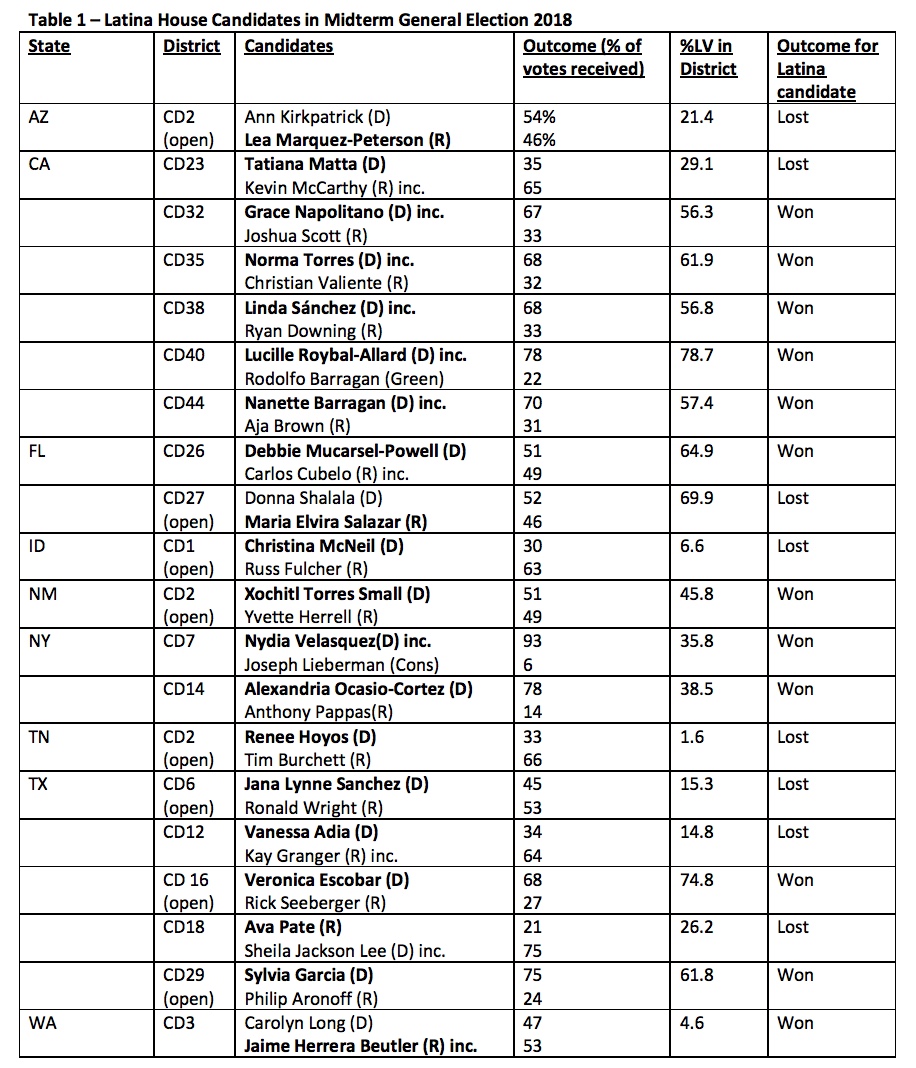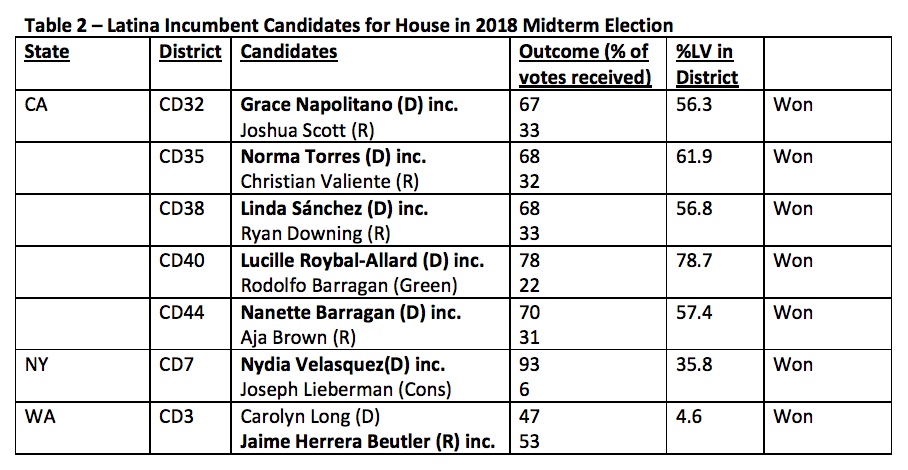Latinas Deliver in the 2018 Midterms
 From March to December 2018, the Barbara Lee Family Foundation (BLFF) and the Center for American Women and Politics (CAWP) partnered to offer Gender Watch 2018, which tracked, analyzed, and illuminated gender dynamics in the 2018 midterm elections. With the help of expert scholars and practitioners, Gender Watch 2018 furthered public understanding of how gender influences candidate strategy, voter engagement and expectations, media coverage, and electoral outcomes in campaigns. The blog below was written for Gender Watch 2018, as part of our collective effort to raise questions, suggest answers, and complicate popular discussions about gender’s role U.S. elections.
From March to December 2018, the Barbara Lee Family Foundation (BLFF) and the Center for American Women and Politics (CAWP) partnered to offer Gender Watch 2018, which tracked, analyzed, and illuminated gender dynamics in the 2018 midterm elections. With the help of expert scholars and practitioners, Gender Watch 2018 furthered public understanding of how gender influences candidate strategy, voter engagement and expectations, media coverage, and electoral outcomes in campaigns. The blog below was written for Gender Watch 2018, as part of our collective effort to raise questions, suggest answers, and complicate popular discussions about gender’s role U.S. elections.
Latinas and Latinos figured prominently into the national political narrative going into the 2018 midterms. The election was replete with campaign hyperbole that traded on racialized and gendered stereotypes of Latinas/os to consolidate a nationalist identity and to mobilize white voters. From the administration’s dismissal of Puerto Rico after the devastation of Hurricane’s Maria and Irma, the execution of a “zero tolerance policy” on undocumented families on the U.S -Mexico border, through the incarceration of more than 2400 children, threats to end birthright citizenship, the deployment of 5,200 troops to the border and the infamous and prolonged derision of a caravan of Central American migrants, Trump engaged in a dizzying array of daily attacks on Latinas/os across the country. And while the President committed to an anti-immigrant strategy, the same narrative was replicated in candidates from Arizona to Pennsylvania who were eager to receive his endorsement and support. Commercial advertisements, robocalls, mailers, and campaign rallies regularly featured racialized and gendered narratives centered on a Latina/o threat with concomitant calls to “build a wall,” “end birthright citizenship” and “keep them out.”
However, the 2018 midterm also proved to be a productive election for expanding the field of Latina candidates as well as the Latina/o electorate. It was an election season where record numbers of Latinas became part of the electoral process as advocates, fundraisers, donors, campaign staff, commentators, canvassers, organizers, voters, and most importantly, candidates. It was a midterm in which women of color, and Latinas specifically, broke barriers to political incorporation, won a record number of Congressional seats around the country, and proved significant to the shift in power in the House. It was a midterm where Michelle Lujan Grisham of New Mexico became the first Democratic Latina (and Democratic woman of color) elected governor in the U.S. Finally, it was an election where five new Latinas were elected to Congress: Alexandria Ocasio-Cortez (NY CD14), Xochitl Torres Small (NM CD2), and Debbie Mucarsel-Powell (FL CD26), and the first Latina Representatives from Texas Veronica Escobar (CD 16) and Sylvia Garcia (CD 29).
Overall, fifty-two Latinas entered the midterms as Congressional candidates (51 in House races, and 1 U.S. Senate candidate), and 20 survived the primary races to advance to the general election. From that field, 12 Latinas won yielding a 30% increase in the total number of Latinas in the House of Representatives. Among these victories were all seven Latina incumbents running for re-election; Representative Ileana Ros-Lehtinen (R-FL) – the first Latina elected to Congress, retired and Representative Michele Lujan Grisham (D-NM) ran successfully for governor of New Mexico. Five of the returning Latinas in the next Congress are from California, plus two more in New York (Nydia Velasquez) and Washington (Jaime Herrera Beutler).
Incumbent Representative Jaime Herrera Beutler (R-WA) will be the lone Republican Latina in the 116th Congress. In fact, 80% of Latinas who won primary contests were Democrats, reflecting both the outcome of a $30 million investment made by the Democratic Congressional Campaign Committee (DCCC) in Latina/o outreach and the favorability of a number of key constituents for Democratic candidates. As Melissa Deckman recently noted, these dramatic differences suggest that despite the increased number of women candidates and women elected to national office this year, there was no “wave” for Republican women as the GOP abandoned previous outreach and recruitment efforts aimed at women and racial/ethnic minorities in exchange for a strategic investment in whiteness and masculinity.
Beyond Democratic party affiliation, Latinas who won their races shared a history of prior political experience. Over 60% of those Latinas who won in primary contests had direct political experience as officeholders (either incumbents or state/local level office), while 75% of Latinas who won in the general election had prior experience. Across all congressional races, incumbent Democrats and Democrats with prior political experience won the preponderance of their races. Even candidates such as Alexandria Ocasio-Cortez (D-NY) and Xochitl Torres Small (D-NM) who were celebrated as Latina “newcomers” were far from inexperienced at politics. Ocasio-Cortez had already established herself as an effective community organizer with organizing skills that served her well in the campaign and Torres Small had a wealth of political experience as aid to Senator Udall, as a judicial law clerk for a federal judge, and attorney versed in environmental law. Thus, despite media coverage that celebrated Latinas and other women of color as political newcomers, most of the Latinas elected were already practiced in varying fields of politics (both electoral politics and non-electoral politics) and their familiarity with multiple forms of politics proved to be an important factor in their overall midterm success.
Finally, almost all Latinas candidates who won their congressional seats came from districts where Latina/o voters represented a critical mass, or at least a third, of the total electorate. California, long a centerpiece of Latina political power, is home to districts with the largest concentration of Latina/o voters ranging from 56.3% of the electorate in CD 32 represented by Grace Napolitano (D), to 78.7% of the electorate in CD40 represented by Lucille Roybal-Allard (D). Not surprisingly, given the concentration of Democratic party power, Latina/o political history, and Latina/o voters in the state, California is also home to the largest concentration of Latina congresswomen and the largest population of Latina incumbents.
Despite California’s political dominance within Latina politics, all five of the Latinas newly elected to Congress were from districts outside the state: specifically Florida, New Mexico, and Texas. And while Debbie Mucarsel-Powell (D-FL) delivered one of the most stunning congressional victories for Latinas, defeating long-time Republican incumbent Carlos Cubelo in Florida’s 26th congressional district, she did so in a district that was majority Latina/o. Republican Jaime Herrera Beutler’s Washington district stands out as Latina/o voters constitute only 4.6% of the electorate, meaning Beutler not only managed a successful re-election campaign in a cycle where incumbent Republicans were regularly defeated, but she also did so in a district where Latina/o voters were vastly outnumbered. This underscores what Christina Bejarano has described as the potential advantages that Latinas have as candidates even in Republican and white dominant districts.
Looking Forward to 2020
This election cycle once again underscored the importance of outreach and mobilization, as well as the power that Latinas hold as candidates and voters. Across the country, Latina/o voter registration and turnout grew, as did the level of support for Democratic candidates. As we have seen with the past elections, Latina voters outnumbered Latinos both in registration and support for Democratic party candidates, reflecting a gender gap in the population. According to the Pew Research Center, 27% of Latina/o voters cast a ballot in a midterm for the first time this election, and in battleground states such as Florida, Latina/o voters grew by 8.4% over 2016. Ultimately, the participation of Latinas as both candidates and voters helped to change the balance of power in the House and challenge an openly racist and misogynistic national narrative on immigration and citizenship.
Looking forward, one of the central questions about this shift in power was recently posed by Ben Lujan, chair of the DCCC. In an interview with the Washington Post he asked:
“Moderate Republicans are voting for our Democratic candidates. As a matter of fact, it’s the only way that many of our candidates are going to win. … But are they aligning with us for one cycle? Has the president pushed them away? … Will they come back while he’s in office? I think those are all important questions that we’ll see election after election. We’ll see now in these midterms. We’ll see again in 2019 with [special elections] and then again in 2020.”
Maintaining and expanding the power that Democrats hold, particularly in the Southwest with seats such as New Mexico’s 2nd congressional district won by Latina Xochitl Torres Small, will depend a great deal on the degree to which the growing Latina/o population who were mobilized in 2018 are successfully incorporated into the party and the larger political processes. This is where the hard work takes place. Democrats not only need to govern on the issues that are important to Latinas/os – and here abating the attacks on immigrants and seeding ground toward immigration reform are front and center, they must also redesign the party to find opportunities for leadership for Latinas/os. This means that they must also shift the party platform and narrative to create a normative description of value for all Latinas/os and not just a chosen few officeholders. This kind of incorporation into the party structure coupled with sustained outreach in places like New Mexico’s CD2, Colorado’s CD 6, or the California central valley can create and sustain the kind of electorate that Democrats need to make sure that gains made in 2018 are not only sustained, but also continue to grow in 2020.
Dr. Anna Sampaio is Director and Associate Professor of Ethnic Studies and Political Science at Santa Clara University. She is the author of Terrorizing Latina/o Immigrants: Race, Gender, and Immigration Politics in the Age of Security (Temple University Press, 2015).



